- Регистрация
- 27 Авг 2018
- Сообщения
- 40,599
- Реакции
- 654,277
- Тема Автор Вы автор данного материала? |
- #1

- Learn core concepts of Machine Learning
- Learn about differnt types of machine learning algorithms
- Build real world projects using Supervised and Unsupervised learning algorithms
- Learn to implement neural networks
- Basic knolwedge of Python is required to compile and run the examples
- Basic knolwedge of mathematics is assumed
Update: This course has been updated to include 8 projects that will give you a real-world experience with different concepts of Machine Learning. Keep an eye out for more projects that will be added to this course in the future!
If you’ve ever wanted Jetsons to be real, well we aren’t that far off from a future like that. If you’ve ever chatted with automated robots, then you’ve definitely interacted with machine learning. From self-driving cars to AI bots, machine learning is slowly spreading it’s reach and making our devices smarter.
Artificial intelligence is the future of computers, where your devices will be able to decide what is right for you. Machine learning is the core for having a futuristic reality where robot maids and robodogs exist. Machine learning includes the algorithms that allow the computers to think and respond, as well as manipulate the data depending on the scenario that’s placed before them.
So, if you’ve ever wanted to play a role in the future of technology development, then here’s your chance to get started with Machine Learning. Because machine learning is complex and tough, we’ve designed a course to help break it down into more simple concepts that are easier to understand.
This course covers the basic concepts of machine learning that are crucial to get started on the journey of becoming a developer for machine learning. This course covers all the different algorithms that are required to simulate the right environment for your computer.
The course will start at the very beginning and delve right into machine learning, before breaking down the most important concepts principles. However, the course does require you to have a mathematical background as machine learning relies heavily on mathematical concepts. It also requires you to have some experience with Python principles which will be required when we put the algorithms to test in actual real-world Python projects.
The course covers a number of different machine learning algorithms such as supervised learning, unsupervised learning, reinforced learning and even neural networks. From there you will learn how to incorporate these algorithms into actual projects so you can see how they work in action! But, that’s not all. In addition to quizzes that you’ll find at the end of each section, the course also includes a 6 brand new projects that can help you experience the power of Machine Learning using real-world examples!
9 Projects That Are Included in This Course:
- Project 1 -Board Game Review Prediction – In this project, you’ll see how to perform a linear regression analysis by predicting the average reviews on a board game in this project.
- Project 2 – Credit Card Fraud Detection – In this project, you’ll learn to focus on anomaly detection by using probability densities to detect credit card fraud.
- Project 3 – Getting Started with Natural Language Processing In Python – This project will focus on Natural Language Processing (NLP) methodology, such as tokenizing words and sentences, part of speech identification and tagging, and phrase chunking.
- Project 4– Obtaining Near State-of-the-Art Performance on Object Recognition Tasks Using Deep Learning – In this project, will use the CIFAR-10 object recognition dataset as a benchmark to implement a recently published deep neural network.
- Project 5 – Image Super Resolution with the SRCNN – Learn how to implement and use a Tensorflow version of the Super Resolution Convolutional Neural Network (SRCNN) for improving image quality.
- Project 6 – Natural Language Processing: Text Classification – In this project, you’ll learn an advanced approach to Natural Language Processing by solving a text classification task using multiple classification algorithms.
- Project 7 – K-Means Clustering For Image Analysis – In this project, you’ll learn how to use K-Means clustering in an unsupervised learning method to analyze and classify 28 x 28 pixel images from the MNIST dataset.
- Project 8 – Data Compression & Visualization Using Principle Component Analysis – This project will show you how to compress our Iris dataset into a 2D feature set and how to visualize it through a normal x-y plot using k-means clustering.
Get started in machine learning with this epic course that makes machine learning simpler and easy to understand! Enroll now to step into the future of programming.
Who this course is for
- Students who will like to understand and use Machine learning in real world projects will find this course very useful
DOWNLOAD:



